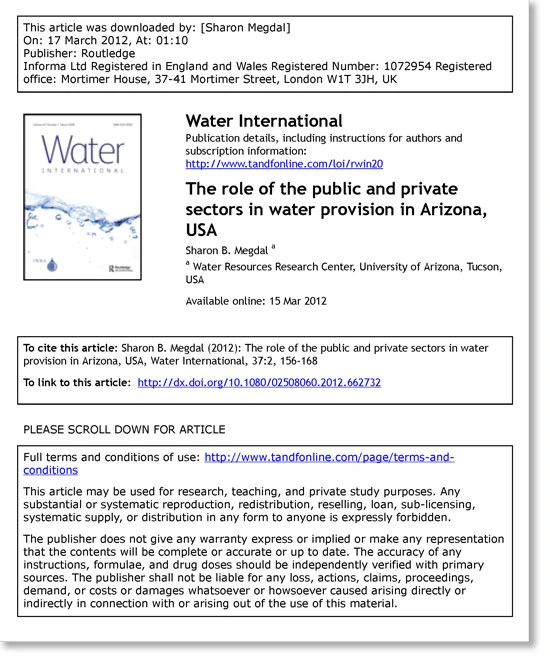
Privatization of water services is a complex issue. Ownership of many water systems in the state has long been in private hands, especially in unincorporated areas. On the other hand, public ownership of water systems is occurring more often in cities and towns. Historically, as areas have incorporated, municipal water utilities have often assumed the ownership of private systems.
Is there a trend toward municipal ownership of water systems in Arizona? If so, what are the reasons for it? Starting with the hypothesis that the trend in Arizona is toward governmental ownership – or municipalization – of water provision, my colleague Jackie Moxley and I have begun investigating these questions. We started by asking: How many water providers in Arizona have switched from public to private versus private to public in the past 20 or so years? Answering this question is not as straightforward as we hoped it would be.1
The reason it is difficult to track ownership is that the Arizona Department of Environmental Quality (ADEQ), the Arizona Department of Water Resources (ADWR), and the Arizona Corporation Commission (ACC) all collect and report data for different water provider activities. ADEQ drinking water system data are based on individual system identification numbers and system names, and are often listed for sub-systems of a single system. The ACC, which regulates privately owned water companies statewide, lists private companies in its annual reports on a consolidated basis. ADWR regulates groundwater used by water companies only in Active Management Areas. In addition, the information they report in their management plans, which are issued every ten years, has changed over time. In short, tracking change in ownership is not an easy task.
Because of these difficulties, our results to date are limited but interesting. Arizona mirrors the nation in that roughly 85 percent of its population is served by publicly owned water systems. Approximately 270 active water providers are regulated by the ACC. Many water systems are small. Based on recent information, 18 of the 20 largest water providers in the state are public water companies. The Phoenix Water Services Department, serving about 1.2 million people, is the largest water provider in the state. When aggregated across their individual systems, privately owned Arizona-American Water Company and Arizona Water Company are the seventh and eighth largest privately owned water companies in the state. Like Arizona Water Company, Arizona-American’s customers are spread over several divisions.
Because of difficulties in tracking ownership data statewide, we have first focused on tracking information for the Tucson region over a period of time. Upon examination of ADEQ and ADWR data, we concluded that between 1985 and 2001, there were some trends. First, we saw a general trend toward consolidation of smaller systems into larger systems. There was an 11 percent decrease in the number of providers serving the Tucson area, even though the Active Management Area population increased 34 percent. In this period, six large providers (serving more than 250 acre feet of water annually) were acquired by public water providers. Interestingly, among the small providers, all but one of the eight new service areas are served by private companies. This suggests that private water companies have a significant role in developing areas where an established water provider, be it public or private, is not nearby.
Interviews provided some reasons for the change from private to public ownership. A key reason was the need for additional financial resources to upgrade infrastructure and to comply with changing environmental regulations. According to a 1999 United States Environmental Protection Agency report, the estimated 20-year investments requirements in Arizona for water system transmission and distribution, treatment, storage and other needs is $1.6 billion. Low profitability of the private operations was also cited as a factor. A Tucson area trend is the formation of Domestic Water Improvement Districts (DWIDs). These can be formed to serve unincorporated areas. In the past 10 years, four new DWIDs have been formed in the Tucson AMA.
We are continuing our research to examine what has occurred in other parts of the state and analyze the implications of public versus private water system ownership. Holding on to subcontracts for Central Arizona Project water had historically posed a problem for private water companies, who could not recover any of the holding costs until the CAP water was considered used and useful. The ACC has recently decided cases that allow for use of CAP water and recovery of the holding costs. Private water company involvement in storage of CAP has increased – for multiple reasons. There is renewed private water company interest in joining the Groundwater Replenishment District and obtaining an assured water designation. We would like to look at water quality compliance and compare performance for public and private water companies.
I expect results will show the trend toward municipalization will continue in and near incorporated cities and towns. I expect we will see consolidation of smaller systems in all areas of the state. Finally, I expect that, regardless of the type of ownership, we will see more sophisticated decision making, as water providers are dealing with the complexities associated with serving growing regions in an ever more demanding regulatory and climatic environment.

